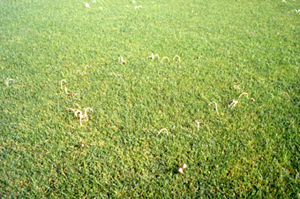G1914
Mushrooms, Fairy Rings, and Other Nuisance Fungi in the Landscape
This NebGuide discusses nuisance fungi commonly found in Nebraska landscapes.
Loren J. Giesler, Extension Plant Pathologist
Nicole D. Haxton, Extension Educator
Mushrooms
Mushrooms are a nuisance to some people or a tasty treat to others. A mushroom is a fruiting structure of a fungus and can be many different shapes and sizes. Some mushrooms and puffballs are edible, but others can be very toxic. Many people like to collect mushrooms such as morels in the early spring due to their delicious taste. However, careful consideration must be taken before harvesting and eating any mushrooms found in the wild.
Mushrooms and puffballs are in the fungi kingdom because they have no chlorophyll, which is used in plants to produce their own food. They also have no roots, stems, leaves, flowers, or seeds like plants do. Because mushrooms and puffballs cannot produce their own food, they must obtain it from the substrate upon which they are living. Typical food sources found in the landscape are soil, wood, other plant tissues, and wastes, including dung, leaves, and other organic matter.
A typical mushroom structure is similar to an umbrella. The cap, also known as the pileus, is attached to the top end of the stalk, called a stipe (Figure 1). On the underside of the cap are the gills. These platelike structures radiate out from the stalk and produce spores that germinate and develop into new mushrooms of the same species. The spore is simply the reproductive structure of a fungus. Mushrooms often live on decaying wood, fallen leaves, and other dead plant material (Figure 2). For a mushroom to appear, certain environmental conditions must exist: It must have a host to live on for nutrients; and it must be a moist environment, such as that which follows a spring rain. Irrigated landscapes provide the moisture, and this is why mushrooms are commonly encountered in well-maintained landscapes.
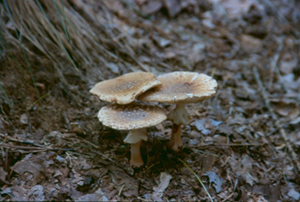 |
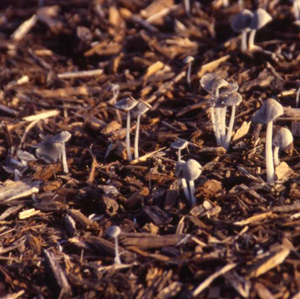 |
|
| Figure 1. Fruiting structure (mushroom) of a fungus growing in mulch. Most nuisance fungi have a cap (pileus) and stalk (stipe). | Figure 2. Mulch beds are common locations for nuisance fungi, such as these inky cap mushrooms. |
Mushrooms are formed from the growth of a large mass of mycelium that is composed of hyphae (individual strands of the fungus). A mycelia mat is not always present with every fungus in the landscape. It can be formed in the thatch layer of the turf and often appears like a mass of fine roots through a large volume of soil. These hyphae can extend over a large area and are similar to roots for a plant. When hyphae develop and have a substrate to feed on — usually decaying organic material — they will form a mushroom at some point. The mushroom then produces thousands of spores to spread the fungus to a new area and food source where they will germinate and eventually produce more mushrooms.
Puffballs
Puffballs (Figure 3) are very similar to mushrooms. Puffballs typically do not have a stalk (stipe) like some other mushrooms to hold the fruiting structure up off the ground. They have a hole, usually at the top, through which the spores are “puffed” out when the ball becomes depressed or struck, e.g., rain drops, and this is how the spores are spread to new areas. The spores inside are dry and powdery. They are usually white at first and eventually change to another color. The ball itself is usually round or pear shaped and can be less than 1 inch or as big as 1 foot in diameter.
Puffballs are commonly found in pastures and meadow areas as well as landscapes. They usually are found in the late summer and fall when they are fruiting. The only real symptom that will appear in the landscape are the puffballs themselves. They are mainly an aesthetic problem and do not cause any real harm to the landscape.
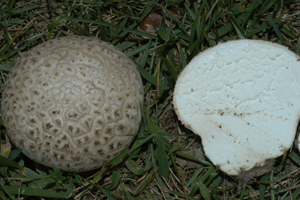 |
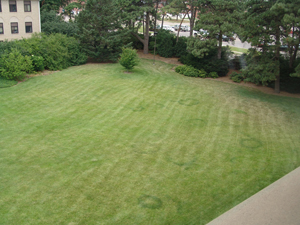 |
|
| Figure 3. Puffballs are identified by their solid structure throughout the fruiting body, which is typically spherical in shape. (Photo courtesy of R. Mulrooney, University of Delaware) | Figure 4. Fairy Ring can be evident as large dark green rings in the turf. (Photo courtesy of T. Jackson, University of Nebraska–Lincoln) |
Fairy Rings
|
Most of the fungi causing Fairy rings (Figure 4) are basidiomycetes, which also are known as the club fungi. The club fungi are the group of mushrooms that contain gills or pores. Fairy rings can go on untreated and not even really noticed due to the mild effect of this turf disease in most landscapes. In some cases, the only symptom that occurs with fairy ring is the resulting fruiting structure or “mushroom” of the fungus. It won’t necessarily damage the turf and landscape plants but can indirectly affect plants in some instances due to the hydrophobic (water repelling) layer that can be formed with very dense hyphal growth, which is referred to as a fungal mat.
Fairy rings are so-named because of the folklore surrounding this fungal disease. Early botanists couldn’t explain this phenomenon that looked like the grass was just worn down in a circular pattern. For centuries people believed that fairies would dance around in circles and cause this condition.
Fairy ring is actually a fungal disease caused by about 50 different species of soil-borne fungi. The most common causal agents of fairy ring are species of Agaricus, Chlorophyllum, Lepiota, and Marasmius.
A couple of different symptoms are associated with Fairy ring in the landscape. The fungus that causes this disease can release nutrients from the activity of the fungus in the soil, which can form a circle, arc, or darker green area of grass that seems to be growing healthier than the surrounding grass. The circle of darker grass can include mushrooms or can also be just a circle of mushrooms or puffballs with no darker grass areas. The size of the fairy ring can range from 1 inch up to 60 feet wide, but most are less than 15 feet.
Usually fairy ring doesn’t affect turf health. It can be aesthetically unpleasant for homeowners who don’t want two different turf colors or mushrooms growing in their lawn, but that is a personal preference with no harm to the lawn. However, the mycelium, a mass of filaments that make up the body of the fungus, can form a dense mat throughout the turf where water cannot get through to the grass roots. This situation can cause death to the grass surrounding the fairy ring.
Other patch-type diseases of turf can be confused with fairy ring. There are two clues used for diagnosing fairy ring: the musty odor and/or the white mycelial growth on the top of the soil or in the thatch layer. The appearance of mushrooms in a circular patch (Figure 5) associated with the symptomatic patch is a definitive sign.
Slime Molds
Slime molds are common in the landscape, but many are too small to notice. The slime molds that most people see are those found on turf grass and other plant leaves and growing on mulch (Figure 6).
Slime molds are fungus-like organisms that are actually myxomycetes and not officially fungi. This organism is characterized as being non-stalked and varies in color. Colors can include white, gray, yellow, and shades of red. The main body of the slime mold, a plasmodium, is one large cell with many nuclei all held together in one large cytoplasm bag. This is the feeding stage of the slime mold and actually is mobile and will move up to several feet a day. When the substrate being used as a food source dries out and conditions for growth are not favorable, the plasmodia aggregate will form spore-producing structures (sporangia). This aggregated body of sporangia is what we typically see as a slime mold. The large clusters aid in our ability to spot them on leaves and mulch.
Other than being aesthetically unpleasant, slime molds pose no threat to the plant upon which they are living. They are only a problem if they develop on a plant for too long and shade it out.
Slime molds typically appear with wet conditions because they require water to release their swimming spores. These spores swim within the water on the leaf surface and pair up to form a mass. They are typically found living on a turf with a thick thatch layer (Figure 7). The thatch layer provides a good supply of organic matter and other food sources because they often feed on the exudates of leaves. These molds can reappear in the same area every year and last for a couple of weeks.
The name “slime mold” is given to this organism because it starts off as a slimy, wet mound. It will eventually harden and become a dusty mass. This dusty mass is the resulting spores that distribute the slime mold. Most mounds of this fungus are fairly small in size but some can get as large as 2 feet in diameter.
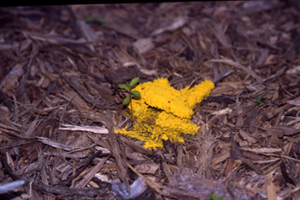 |
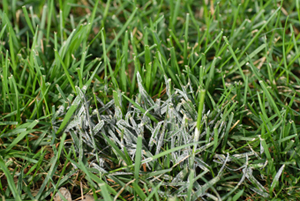 |
|
| Figure 6. Slime molds can vary in color from white to this bright yellow color and often occur on mulch. | Figure 7. Slime molds occurring in turf are typically gray to white in color. (Photo courtesy of Stephen Wegulo, University of Nebraska–Lincoln) |
Bird’s Nest Fungus
Bird’s nest fungus is a type of fungus commonly found in mulched areas of the landscape. It is called bird’s nest fungus because the fungus actually looks like tiny little bird’s nests filled with tiny eggs (Figure 8). Each of these “nests” is a half inch or less in diameter.
Bird’s nest fungus is typically caused by a fungus in the genus Cyathus or Crucibulum. The groupings can be quite large. This type of fungus is also a basidiomycete. The egg-shaped structures are actually the basidiocarps, the spore-producing fruiting structures for the fungus.
The life cycle of bird’s nest fungus is quite similar to that of puffballs. The fungus on a growing site, such as mulch, forms the egg-shaped, fruiting structures. Then, as rain and other water is splashed onto the Bird’s nest, it splashes the spores out and onto a new area to colonize.
Bird’s nest fungus is commonly found growing on mulch throughout the year. Due to its small size, Bird’s nest fungus is not an aesthetic problem. A closely related fungus, known as artillery fungus, is a major nuisance in states east of Nebraska but has not been observed in Nebraska. The artillery fungus is known to shoot its sticky spores onto houses and stain siding and other exterior surfaces.
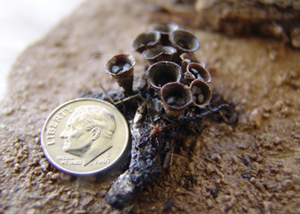 |
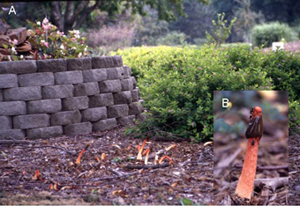 |
|
| Figure 8. Bird’s Nest Fungus is common in mulch beds. It also grows on various organic materials, including thatch in the turf. | Figure 9. (A) Stinkhorns occur primarily in mulch or where organic material has been buried. (B) Flies disseminate the spores of the stinkhorn fungus. |
Stinkhorns
Stinkhorns are also in the Basidiomycetes group of fungi found in the landscape. Stinkhorns (Figure 9) are so named because they have an unpleasant odor. Most stinkhorns in Nebraska are basidiomycetes in the genus Mutinus and Phallus. Stinkhorns have a white, spongy stalk that may or may not have a cap on it. The top portion of the stalk is usually colored.
The spores are located in a smelly mass on the cap of the fruiting structure. Stinkhorn fungus spores are often spread by flies and other insects attracted to the smell (Figure 9B). The young fruiting bodies are white and spherical (egg-shaped) and partially submerged in soil or mulch. As the fruiting body matures, the egg-like structure (ovule) ruptures and the stalk emerges. This will often occur overnight.
Stinkhorns are either found scattered about the landscape or in groupings, usually in the lawn or mulch. This type of mushroom is found in mid-summer and fall.
Management Methods
The management techniques for all of these fungi that have been discussed are quite similar:
- Physical removal of fruiting structures (Keep in mind that many of these can be poisonous for pets and humans).
- Removal of the organic material the fungus is growing on.
- Cleaning up the landscape to reduce future food sources of these fungi.
- Manage turf areas to limit thatch accumulation.
- Use of conifer-based mulches that do not favor fungal growth as much as deciduous wood mulches.
- Fairy ring can be managed by:
- Masking the green color in the lawn with iron or fertilizer applications.
- Spot watering and breaking up the fungal mat in areas where turf is stressed by fungal mat development.
This publication has been peer reviewed.
Visit the University of Nebraska–Lincoln Extension Publications website for more publications.
Index: Plant Diseases
Turf
Issued June 2011
